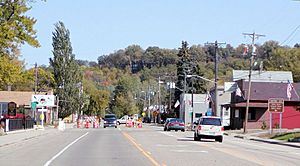Mendota, Minnesota facts for kids
Quick facts for kids
Mendota
|
|
|---|---|

Highway 13 in Mendota
|
|

Location of the city of Mendota
within Dakota County, Minnesota |
|
| Country | United States |
| State | Minnesota |
| County | Dakota |
| Area | |
| • Total | 0.29 sq mi (0.76 km2) |
| • Land | 0.27 sq mi (0.69 km2) |
| • Water | 0.03 sq mi (0.07 km2) |
| Elevation | 768 ft (234 m) |
| Population
(2020)
|
|
| • Total | 183 |
| • Density | 690.57/sq mi (266.79/km2) |
| Time zone | UTC-6 (Central (CST)) |
| • Summer (DST) | UTC-5 (CDT) |
| ZIP code |
55150
|
| Area code(s) | 651 |
| FIPS code | 27-41678 |
| GNIS feature ID | 0647762 |
| Website | www.cityofmendota.org |
Mendota is a small city in Dakota County, Minnesota, United States. The name "Mendota" comes from a Dakota word, bdóte. This word means "the meeting point of two rivers," specifically the Minnesota and Mississippi Rivers. In Dakota tradition, this spot is considered the center of the world. In 2020, about 183 people lived in Mendota.
Contents
Exploring Mendota's Past
Mendota was one of the first places in Minnesota where European-Americans settled permanently. It was founded around the same time as Fort Snelling, an important early fort.
Historic Buildings and Sites
Mendota is home to the Sibley Historic Site. Here you can find some of the oldest stone buildings in Minnesota.
- The Henry Hastings Sibley house was built in the 1830s. Sibley later became the first Governor of Minnesota.
- The Faribault house also dates back to the 1830s.
- Other buildings linked to the American Fur Company are also found here.
- The Dupuis House was built in 1854. It was the first red brick house in Mendota. Hypolite Dupuis worked for Sibley and built this home for his family.
Main Roads and Local Community
The main road through Mendota is State Highway 13. It is also known as Sibley Memorial Highway. Most other roads in the city are small and not paved.
Mendota is also home to the Mendota Mdewakanton Dakota Tribal Community. This is a Native American community in Minnesota. They have been working to gain official federal recognition since 1996. They are a registered non-profit organization. Their community formed after special laws were passed in the late 1800s for the "Sioux in Minnesota."
Mendota's Location and Landscape
Mendota covers a total area of about 0.76 square kilometers (0.29 square miles). Most of this area is land, with a small part being water.
Where Rivers Meet
The city of Mendota is located where the Mississippi River and the Minnesota River join together. This meeting point is very important to the Dakota people. The city is mostly surrounded by the larger city of Mendota Heights. Fort Snelling State Park is also very close by.
Population Over Time
| Historical population | |||
|---|---|---|---|
| Census | Pop. | %± | |
| 1880 | 348 | — | |
| 1890 | 248 | −28.7% | |
| 1900 | 282 | 13.7% | |
| 1910 | 245 | −13.1% | |
| 1920 | 193 | −21.2% | |
| 1930 | 173 | −10.4% | |
| 1940 | 228 | 31.8% | |
| 1950 | 243 | 6.6% | |
| 1960 | 259 | 6.6% | |
| 1970 | 266 | 2.7% | |
| 1980 | 219 | −17.7% | |
| 1990 | 164 | −25.1% | |
| 2000 | 197 | 20.1% | |
| 2010 | 198 | 0.5% | |
| 2020 | 183 | −7.6% | |
| U.S. Decennial Census | |||
People in Mendota (2010 Census)
In 2010, there were 198 people living in Mendota. These people lived in 78 households, with 52 of them being families. The city had about 733 people per square mile.
Most residents (91.4%) were White. Other groups included African American (1.5%), Native American (1.5%), and Asian (2.0%). About 3.5% of the population was Hispanic or Latino.
The average age in Mendota was 37.8 years.
- About 26.8% of residents were under 18 years old.
- About 10.1% were 65 years or older.
- The population was almost evenly split between males (47.5%) and females (52.5%).
Well-Known People from Mendota
Many interesting people have lived in Mendota. Here are a few:
- Timothy J. Corbett: He was the first Roman Catholic bishop of the Diocese of Crookston.
- Hypolite Dupuis: He worked for Henry H. Sibley and arrived in Mendota in 1842.
- Jean-Baptiste Faribault: A trader and one of Minnesota's first settlers.
- Joseph Godfrey: The only African American who fought in the Dakota War of 1862.
- Henry H. Sibley: He was Minnesota's first Governor. He came to Mendota in 1835.
See also
 In Spanish: Mendota (Minnesota) para niños
In Spanish: Mendota (Minnesota) para niños

